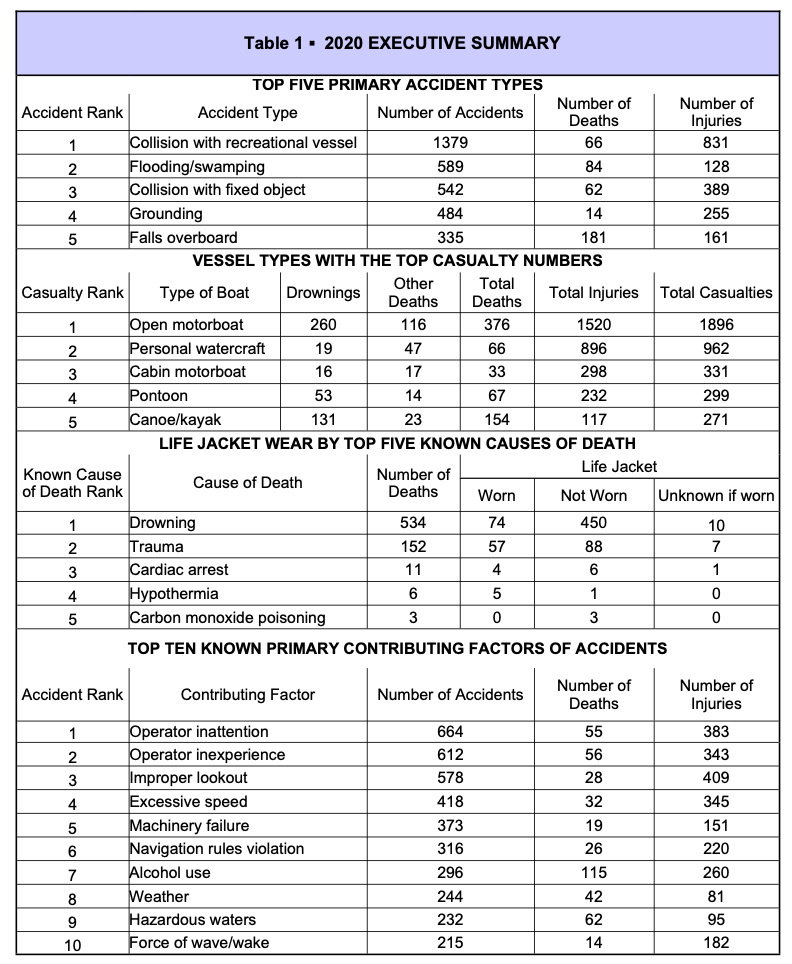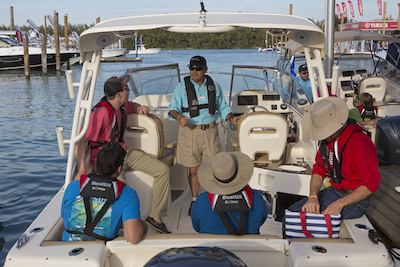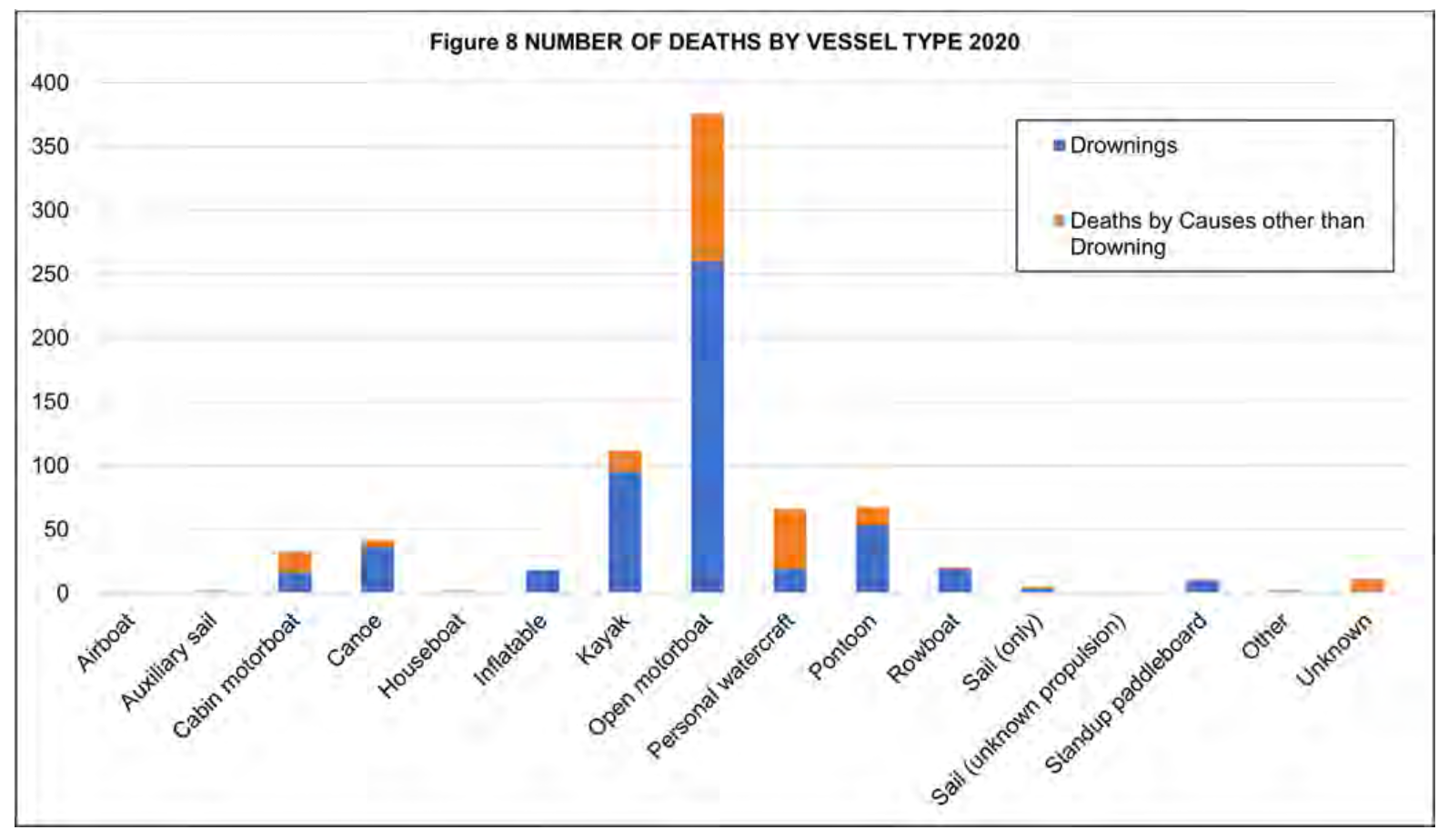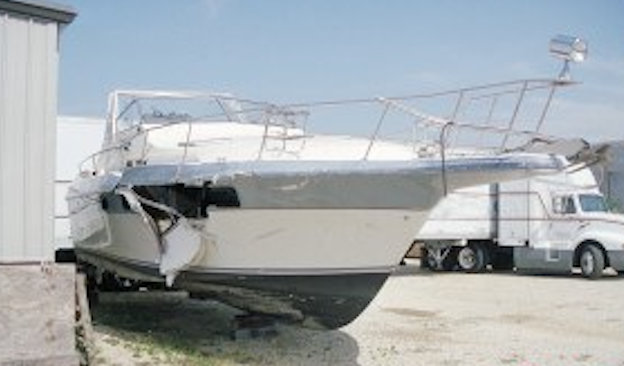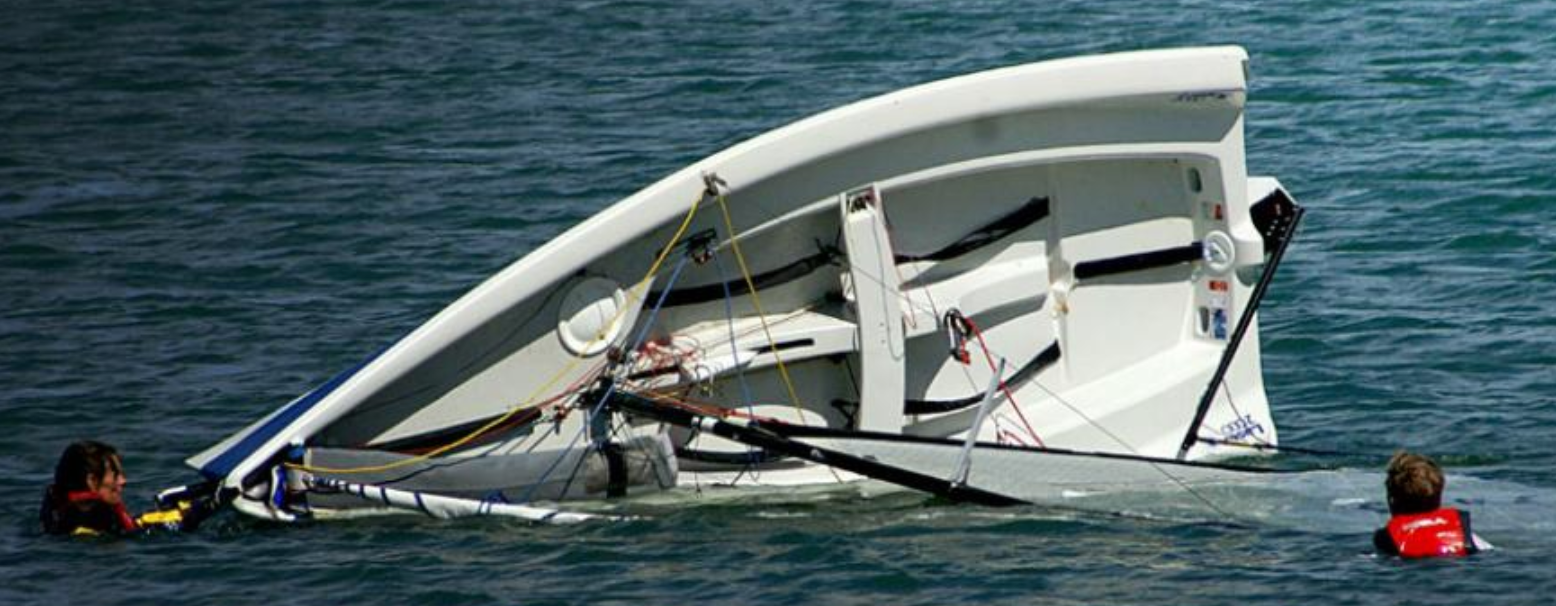Coast Guard Releases 2020 Accident Statistics
In the calendar year 2020, the United States Coast Guard recorded 5,265 recreational boating accidents nationwide that involved 767 deaths, 3,191 injuries and resulted in approximately $62.5 million in damage to property. The fatality rate for 2020 was 6.5 deaths per 100,000 registered recreational vessels. This represented a 25% increase from the 2019 fatality rate of 5.2 deaths per 100,000 registered recreational vessels. Compared to 2019, the number of accidents increased by 26.3%, the number of deaths increased by 25.1% and the number of injuries increased by 24.7%.
In the summary, the Coast Guard said there was an increase in recreational boating activity during the COVID-19 pandemic based on reports of increased boat sales, insurance policies procured, insurance claims and calls for towing assistance. Many states cited difficulties registering boats because of office closures during the pandemic.
The 11,838,188 recreational vessels registered nationwide in 2020 represent a .34% decrease from last year when 11,878,542 recreational boats were registered.
Common Sense
Where the cause of death was known, 75% of fatal boating accident victims drowned. Of those incidents with reported life-jacket usage, 86% of the victims were not wearing a personal flotation device (pfd).
Where the length of the boat was known, eight out of every 10 boaters who drowned were on a vessel less than 21’ (6.4 m) long.
Sadly, alcohol is a leading known contributing factor in fatal boating accidents. Where the primary cause was known, alcohol was the leading factor in 18% of deaths.
Where operator instruction level was known, 77% of the deaths on the water occurred on boats where the operator did not receive boating safety instruction. Only 12% of fatalities occurred on a vessel where the operator was known to have received a nationally approved boating-safety education certificate. Operator inattention, driver inexperience, improper lookout, excessive speed and machinery failure ranked as the top five primary contributing factors in accidents.
Additional Statistics
The Coast Guard said that there were 247 accidents in which at least one person was struck by a propeller. Collectively, these accidents resulted in 39 deaths and 241 injuries. Where the data was known, the most common vessel types involved in reported accidents were open motorboats (46%), personal watercraft (22%) and cabin motorboats (13%). Additionally, the vessel types with the highest percentage of deaths were open motorboats (50%), kayaks (15%) and pontoon boats (9%).
The highest number of accidents and injuries came in collisions with another vessel. The total number of collisions in 2020 was 1,379 and in those accidents, there were 66 fatalities and 831 injuries. Second was flooding/swamping at 589 incidents with 84 deaths and 128 injuries. Third was colliding with a fixed object at 542 total accidents, 62 deaths and 389 injuries. Vessel grounding was fourth at 484 accidents, 14 deaths and 225 injuries followed by falls overboard at 335 total incidents, 181 deaths and 161 injuries.
Ranking the vessel types with the top casualty numbers, open motorboats had the highest number of total casualties at 1,896 with 1,520 total injuries and 376 total deaths including 260 drownings. Additionally, more people drowned in boats shorter than 16’ (4.88 m), followed by boats measuring 16’ (4.88 m) to 26’ (7.92 m) long.
Personal watercraft (pwc) ranked second in total casualties at 962 and 896 total injuries. Of the total 66 pwc deaths, 19 were drowning and 47 were listed as “other.” Cabin motorboats had 331 total casualties with 298 total injuries and 33 deaths including 16 by drowning. Pontoon boats ranked fourth at 299 total casualties, 232 total injuries and 67 total deaths including 53 drownings while fourth went to canoes/kayaks at 271 total casualties and 117 total injuries, but it’s worth noting that these watercraft had 131 drownings out of 154 total deaths.
Looking at the wearing of life jackets in accidents, in the 534 drownings in 2020, the Coast Guard said that the victim wasn’t wearing one in 450 of the accidents compared to only 74 being worn. Of the 152 deaths attributed to trauma, 88 victims weren’t wearing a life jacket and in the 11 deaths from cardiac arrest, six victims did not wear a pfd. Six deaths in 2020 were attributed to hypothermia and in five of them, the victim wore a lifejacket. Finally, of the three people who died from carbon-monoxide poisoning, none wore a pfd.
Contributing Factors
They’re called “accidents” but for most of these incidents, there’s at least one contributing factor. The top contributing factor in boat accidents was operator inattention. It was listed as the primary cause in 664 accidents that resulted in 55 deaths and 383 injuries. Not far behind, operator inexperience caused 612 accidents with 56 deaths and 343 injuries. Improper lookout was blamed for 578 accidents, 28 deaths and 409 injuries while excessive speed was credited with 418 accidents, 32 deaths and 345 injuries. Machinery failure rounded out the top five with 373 accidents, 19 deaths and 151 injuries. The balance of the top 10 is as follows, navigation rules violation, alcohol use, weather, hazardous waters and force of wave/wake.
Looking at the operator age in accidents, there were 7,248 vessels involved in accidents in 2020 and the leading operator age group was 36 to 55 years with 2,165 vessels, 243 deaths and 1,196 injuries. Operators over 55 years were at the helm in 1,375 accidents that resulted in 252 deaths and 502 injuries. Operators age 26 to 35 were in control for 1,021 accidents that caused 129 deaths and 542 injuries.
Required Reporting
Under federal regulations (33 CFR Part 173; Subpart C — Casualty and Accident Reporting) the operator of any numbered vessel that was not required to be inspected or a vessel that was operated for recreational purposes is required to file a Boating Accident Report (BAR) when, as a result of an occurrence that involves the vessel or its equipment in the following scenarios:
- A person dies; or
- A person disappears from the vessel under circumstances that indicate death, or injury; or
- A person is injured and requires medical treatment beyond first aid; or
- Damage to vessels and other property totals $2,000 or more; or
- There is a complete loss of any vessel
If the above conditions are met, the federal regulations state that the operator or owner must report his accident to a state reporting authority. The authority can be either the state where the accident occurred, the state in which the vessel is numbered or, if the vessel does not have a number, the state where the vessel was principally used. The owner must submit the report if the operator is deceased or unable to make the report.
The regulations also state the acceptable length of time in which the accident report must be submitted to the authorities. Boat operators or owners must follow these guidelines:
•An accident must be reported within 48 hours of an occurrence if a person dies within 24 hours of the event, a person requires medical treatment beyond first aid or a person disappears from the vessel. If there is damage to the vessel or property only, an accident report must be filed within 10 days of the incident.
Minimum reporting requirements are set by federal regulation, but states can have more stringent requirements. For example, some states have a lower threshold for reporting damage to vessels and other property. Federal regulations also require accident report data to be forwarded to the Coast Guard Headquarters within 30 days of receipt by a state or its agent.
Reportable vs. Non-Reportable Accidents
Casualty and accident reporting applies to each vessel used by its operator for recreational purposes or vessels that are required to be numbered. The following watercraft are considered to be vessels that would be required to report an accident: airboat, auxiliary sailboat, cabin motorboat, canoe, houseboat, inflatable boat, kayak, open motorboat, personal watercraft, pontoon, raft, rowboat, sailboat and stand-up paddleboard. A toy like an unmodified inner tube is not a vessel.
A vessel is considered to have been involved in an “boating accident” whenever a death, missing person, personal injury, property damage, or total loss results from the vessel’s operation, construction, seaworthiness, equipment or machinery.
The following are examples of accident types that are “reportable:”
- Grounding, capsizing, sinking or flooding/swamping.
- A person falls overboard from a vessel.
- A person(s) is ejected from a vessel.
- Fire or explosions that occur while underway and/or anchored, moored or docked if the fire results from the vessel or vessel equipment.
- Water-skiing or other mishap involving a towable device.
- Collision with another vessel or object
- A person struck by a vessel, propeller, propulsion unit or steering machinery.
- Carbon monoxide exposure.
- Electrocution due to stray current related to a vessel.
- Casualties where natural causes served as a contributing factor in the death of an individual but the determined cause of death was drowning.
- Casualties from natural phenomena such as an interaction with marine (i.e. carp causes casualty to person) and interaction with nature (i.e. mountain side falls onto vessel causing casualties.)
- Casualties where a person falls off an anchored vessel.
- Casualties that result when a person departs an anchored, disabled vessel to make repairs, such as unfouling an anchor or cleaning out the intake of a jet-propelled vessel.
The following occurrences involving a vessel are considered “non-reportable” boating accidents:
- A person dies, is injured, or is missing as a result of self-inflicted wounds, alcohol poisoning, gunshot wounds, or the ingestion of drugs, controlled substances or poison.
- A person dies, is injured, or is missing as a result of assault by another person or persons while aboard a vessel.
- A person dies or is injured from natural causes while aboard a vessel where the vessel did not contribute to the casualty.
- A person dies, is injured, or is missing as a result of jumping, diving or swimming for pleasure from an anchored, moored or docked vessel.
- A person dies, is injured, or is missing as a result of swimming to retrieve an object or vessel that is adrift from its mooring or dock, having departed from a place of inherent safety, such as the shore or pier.
- Property damage occurs or a person dies, is injured, or is missing while preparing a vessel for launching or retrieving and the vessel is not on the water and capable/ready for its intended use.
- Property damage occurs to a docked or moored vessel or a person dies, is injured, or is missing from such a vessel as the result of storms, or unusual tidal or sea conditions; or when a vessel gets underway in those conditions in an attempt to rescue persons or vessels.
- Property damage occurs to a docked or moored vessel due to lack of maintenance on the vessel or the structure to which it was moored.
- Property damage occurs to a docked or moored vessel due to theft or vandalism.
- Property damage occurs to, a person dies or is injured on, or a person is missing from a non-propelled residential platform or other watercraft used primarily as a residence that is not underway.
- Casualties that result from falls from or on docked vessels or vessels that are moored to a permanent structure.
- Casualties that result from a person climbing aboard an anchored vessel from the water or swimming near an anchored vessel (unless the casualty was related to carbon-monoxide exposure or stray electric current.)
- Fire or explosions on anchored, docked or moored boats where the cause of fire was not attributed to the vessel or vessel equipment.
- Casualty or damage that results when the vehicle used for trailering the vessel fails.
- Casualties or damage that occur during accidents that only involve watercraft that have not been deemed a vessel.
- Casualties or damage that occur when only the vessel(s) involved are being used solely for governmental, commercial or criminal activity.
- Casualties or damage that occur when only the vessel(s) involved are not required to be numbered and are being used exclusively for racing.
- Casualties or damage that occur when only the vessel(s) are foreign vessels and thus not subject to U.S. federal reporting requirements.
Planned Response
The Coast Guard has released the Strategic Plan of the National Recreational Boating Safety Program for 2017-2021 to address the following initiatives: improve and expand recreational boating education, training and outreach; update, leverage and enforce policies, regulations and standards and; improve upon and expand recreational boating data collection and research. Parties interested in viewing the plan can visit www.uscgboating.org/content/strategic-plan.php.
As a result of the changes in 33 CFR 174.19 that took effect January 1, 2017, a new term “paddlecraft” was introduced and defined as “a vessel powered only by its occupants, suing a single or double-bladed paddle as a lever without the aid of a fulcrum provided by oarlocks, thole pins, crutches or similar arrangements.” The definition limits the use of the term to non-motorized vessels. Any canoe or kayak with a motor is classified as an “open motorboat” for accident reporting and registration purposes.

